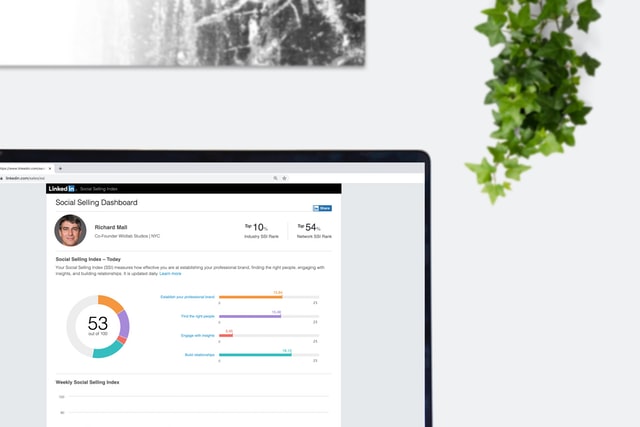As anyone involved in B2B sales knows, even the most well thought out plans can fall by the wayside at times. No matter whether you think you’ve accounted for every variable, there can be unexpected events that mean the plan has to change. However, when you set goals and objectives, it doesn’t matter if your plan changes – you still know what your ultimate aim is. With that in mind, we take a look at setting campaign goals on LinkedIn. We explore why they matter, what types there are, and how you set and measure these LinkedIn campaign goals.
Why do Campaign Goals Matter?
Before we get into the details of how to set campaign goals and Linked KPIs, let’s first turn our attention to why they matter in the first place. Some people are eager to simply get things like their lead generation campaign up and running. Although taking action in these areas is often beneficial, there are reasons why setting objectives is important:
- It helps everyone. Communication is a vital quality within your sales team and marketing team. Talking through campaign goals allows you to make sure that everyone is on the same page and working towards the same end.
- It gives a clear vision. As we’ll see, setting objectives gives a specific and measurable vision to your efforts. You can see where you’re heading, no matter what else happens during the campaign.
- It provides a measure for success. When you have campaign goals in place, it’s far easier to determine whether or not your efforts have been successful. This, in turn, allows you to make adjustments for future campaigns.
From a marketing and sales perspective, it’s easy to see why setting campaign goals is so essential. It benefits everyone in the process and can help you boost sales.
Types of Campaigns and Sample Goals
It can sometimes be difficult to determine what types of campaign goals you should set. You may assume that making money is the ultimate objective for a business, but such an aim isn’t always that clear. Instead, you need to set SMART goals. This means they should be:
- Specific. First of all, your goal should be clear and straightforward. You need to think about what you want to accomplish, why it’s important, who’s involved, where it’s located, and which resources are involved.
- Measurable. As we mentioned above, your objectives should be easy to measure, allowing you to understand how close you are to attaining it and when you’ve achieved it.
- Attainable. Although your campaign goal should stretch your abilities, it should still be within the realm of possibility. You need to take into account all of the potential barriers to success to make sure you can achieve it.
- Relevant. Your aims should be relevant to the other goals of the business. It should be timely, worthwhile, and match your other efforts.
- Time-specific. Don’t let your campaign objectives be open-ended. You need a time-bound goal that means you can gradually work towards the ultimate aim.
Examples of campaigns and goals
Now that we know the characteristics of a campaign goal, let’s look at some types of campaigns you might run, as well as some goals that you could use:
- Promote a new product or service. This campaign focuses on building awareness of something new that you’re offering. A suitable goal could be to increase the number of inquiries about the product by 25% by the end of the year.
- Lead generation. To start filling your sales pipeline, you’ll want to focus on attracting new prospects. For lead generation goals, something like increasing your LinkedIn followers by 500 by Q3 is a good example.
- Build brand awareness. To increase your business’ audience, you might want to focus on driving awareness of your brand. A goal example would be to increase social media impressions by 30% by the end of the year.
How to Set Campaign Goals
It’s all very well understanding what SMART goals are and what other companies have done, but what about setting your own campaign goals? Although the exact objectives will depend entirely on your organization, there are some clear steps you can take to set your campaign goals:
Create a Clear Strategy
What is the main reason you want to run this campaign? This is the first question you’ll need to ask when coming up with a strategy. As we’ve seen above, there are multiple purposes that you can run a campaign for; it’s up to you to choose one that’s relevant.
Once you have this reason firmly in mind, you can start thinking about some of the ways in which you can run the campaign. Whether through outreach, direct marketing, email marketing strategies, or a combination of many other elements, you need to have a clear plan for how your campaign is going to operate. With this in place, you can then start thinking about some of your campaign goals.
Write down the Goals

Again, it’s time to refer back to the SMART goals that we’ve outlined above. However, before you get into the specifics of what you want your measurable goals to be, you can start at a broader level. Start thinking about what you want to achieve with your lead gen campaign, for example.
As your broader goals start to emerge, you can start delving into some of the more detailed ways in which you can achieve them. There are likely to be multiple smaller goals and objectives that you can start working towards before you reach your ultimate aim.
This is where you want to start being specific and realistic. Introduce your timelines for when you want to achieve your lead generation goals, as well as how you’ll measure their success.
This part of the process may take a while, as you should ideally keep refining and redefining your goals until they hit all of the SMART measurements.
Calculate it
Of course, for our lead generation goals, we want to make sure that you’re hitting your numbers. This is where you start needing to use campaign goal calculations. For example, you might be working towards the total number of customers needed for your campaign to be successful. Similarly, you may want to work towards the total percentage of leads that become customers.
Whichever goal you have for your lead gen, you should work out an accurate calculation for what success looks like, and start working towards that. By the end of the campaign, you can then measure how well you’ve performed and set more accurate goals for the next one.
Define Clear Marketing Objectives
We’ve already briefly mentioned some of the marketing objectives you might set for your campaign. However, it’s worth exploring some of these in more detail. This will help you understand what strong goals look like, as well as how you can use LinkedIn metrics and LinkedIn KPIs to measure them.
Examples of Marketing Objectives
Below, we’ve picked out four examples of marketing objectives to explore further. Of course, there are plenty of other aside from these, but hopefully, they can give you some inspiration:
Lead Generation
There are several factors to consider when lead generation is your main campaign goal. As well as capturing new leads, you may also want to qualify and segment them. Again, there are various ways that you can quantify these goals, including:
- An increase in web traffic. Increasing your audience is a popular way of gathering momentum across your business.
- Converting prospects. It’s one thing generating leads, but you may also want to convert them from prospects into customers.
- Boost your sales. Lead gen can often be a stepping stone to overall increased sales. Nurturing leads often sees them return to you for business.
Target new customers
Targeting new customers is closely linked to a lead generation strategy. However, there are other factors to consider, as well:
- Understanding your target market and their needs
- Developing customer personas to refine your segmentation
- Attracting new, high-quality leads to the business
- Engage with LinkedIn Groups to drive new leads
Increase Sales and/or Revenue
Of course, your campaign goals could be focused on the sales sides of things. As well as finding new leads, you may also want to think about:
- Your business cycle time
- Your churn rate
- Customer win rate
- Cross-sell and upsell potential
Increase Profit
Your profit is closely linked to your sales, but there are some obvious differences. If your campaign goals are focused on profit, why not consider:
- Expanding your market share
- Increasing your market penetration
- Diversifying your product offering
KPIs to Assign to Marketing Objectives
Now that we know a little more about how to define your campaign goals, it’s time to look at how you can measure their success. Some of this will depend on the medium through which you’re running your campaign. For the same of this article, we’ll continue mainly focusing on LinkedIn lead gen goals and relevant KPIs.
There are various LinkedIn metrics and KPIs that you can use to measure success. Many of these can be accessed through the LinkedIn Sales Navigator tools, giving a wide range of insights. These LinkedIn KPIs give you a firmer grasp of how things like your lead generation activities are performing.
Below, we’ve highlighted some of the key performance indicators you might want to consider. Many of these are lead gen KPIs, while others are more general:
- Web traffic. How many new visitors are you attracting from your LinkedIn lead generation campaign?
- Sales Growth. What is the level of new business that you’ve achieved through your activities on LinkedIn?
- Lead Gen. How many new hot leads have you generated? What is the likelihood that you’ll be able to convert them?
- Profit changes. What impact has your marketing efforts had on your overall profit? Has the ROI made it worthwhile?
- SEO Performance. How have your marketing activities impacted your rank for relevant search terms?
Measuring Campaign Goals
Once you have outlined both your goals and your KPIs, it’s time to think about how you’re going to measure and analyze your success. The effectiveness of your lead generation campaign can then be used to inform future efforts, offering a more refined and insightful approach.
As well as knowing what is working and how well, you also need to consider what isn’t working and why that might be. Not every campaign will be successful, after all. Here are some tips on utilizing your results, whether for lead generation campaigns or otherwise:
- Explore the data. Perhaps the most valuable way of measuring the efficacy of a campaign is to delve into the data. LinkedIn provides a whole range of metrics, as do tools such as Google Analytics.
- Look at multiple measurements. Although your KPIs are perhaps the most essential measurements, there are others to consider as well. Look at secondary metrics such as ad clicks, blog comments, and social media mentions.
- Talk to your team. Customer data is, of course, the most valuable measure of your campaign goals. However, you should also pay attention to your sales team and salespeople to get their insights.
Steps to Execute a Successful Lead Generation Campaign
To conclude, let’s sum up some of the advice we’ve outlined into actionable steps. Below, you’ll find a breakdown of the process you might want to try for a successful lead generation campaign:
- Establish your objective. As established, this in itself is a multi-stage process and an important first step.
- Do your research. Based on your objectives, you should start researching your target market and demographic to come up with customer personas.
- Plan your activities. At this stage, you want to think about some of the content you want to create and how you’ll promote it.
- Create a lead magnet. Here, you want to think of an offer that is going to entice your targets to transition into the sales funnel.
- Promote your content/offer. Now is the time for action. You can execute the planning stages, promoting your content and offer across multiple platforms.
- Refine your process. As the process starts, you should be able to identify how your lead generation efforts are going. Now is the time to make any necessary adjustments.
- Score your leads. Here, you want to outline the potential for leads to convert, including where they are in your sales funnel.
- Engage your leads. Based on your efforts thus far, you should be able to start reaching out to your leads, nurturing trust, and moving them through your sales process.
- Measure the results. Once the campaign is done, it’s time to take stock. Did you meet your campaign goals? Where could you make improvements? What can you learn for next time?
Although it seems simple when written down in such brief steps, there is clearly a lot of work to do at each step. However, knowing your campaign goals upfront gives you a solid basis for the rest of your activities.




 Messaging: Identifying USP & Customer Pain Points
Messaging: Identifying USP & Customer Pain Points 
